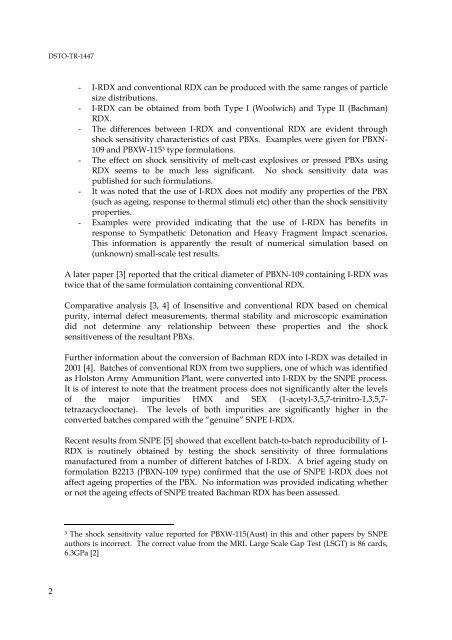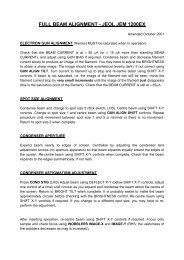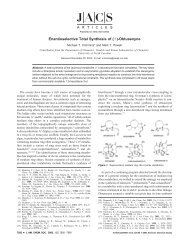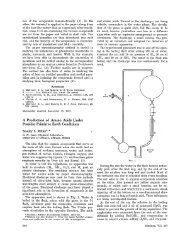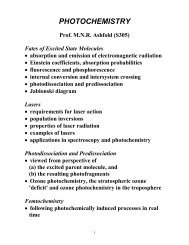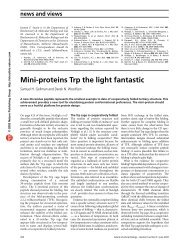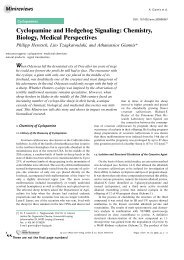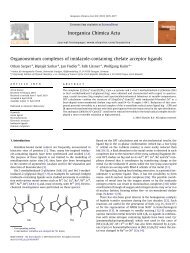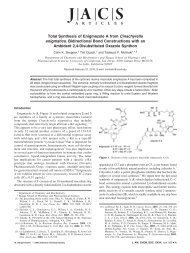Reduced Sensitivity RDX (RS-RDX) Part I: Literature Review and ...
Reduced Sensitivity RDX (RS-RDX) Part I: Literature Review and ...
Reduced Sensitivity RDX (RS-RDX) Part I: Literature Review and ...
Create successful ePaper yourself
Turn your PDF publications into a flip-book with our unique Google optimized e-Paper software.
DSTO-TR-1447<br />
2<br />
- I-<strong>RDX</strong> <strong>and</strong> conventional <strong>RDX</strong> can be produced with the same ranges of particle<br />
size distributions.<br />
- I-<strong>RDX</strong> can be obtained from both Type I (Woolwich) <strong>and</strong> Type II (Bachman)<br />
<strong>RDX</strong>.<br />
- The differences between I-<strong>RDX</strong> <strong>and</strong> conventional <strong>RDX</strong> are evident through<br />
shock sensitivity characteristics of cast PBXs. Examples were given for PBXN-<br />
109 <strong>and</strong> PBXW-115 3 type formulations.<br />
- The effect on shock sensitivity of melt-cast explosives or pressed PBXs using<br />
<strong>RDX</strong> seems to be much less significant. No shock sensitivity data was<br />
published for such formulations.<br />
- It was noted that the use of I-<strong>RDX</strong> does not modify any properties of the PBX<br />
(such as ageing, response to thermal stimuli etc) other than the shock sensitivity<br />
properties.<br />
- Examples were provided indicating that the use of I-<strong>RDX</strong> has benefits in<br />
response to Sympathetic Detonation <strong>and</strong> Heavy Fragment Impact scenarios.<br />
This information is apparently the result of numerical simulation based on<br />
(unknown) small-scale test results.<br />
A later paper [3] reported that the critical diameter of PBXN-109 containing I-<strong>RDX</strong> was<br />
twice that of the same formulation containing conventional <strong>RDX</strong>.<br />
Comparative analysis [3, 4] of Insensitive <strong>and</strong> conventional <strong>RDX</strong> based on chemical<br />
purity, internal defect measurements, thermal stability <strong>and</strong> microscopic examination<br />
did not determine any relationship between these properties <strong>and</strong> the shock<br />
sensitiveness of the resultant PBXs.<br />
Further information about the conversion of Bachman <strong>RDX</strong> into I-<strong>RDX</strong> was detailed in<br />
2001 [4]. Batches of conventional <strong>RDX</strong> from two suppliers, one of which was identified<br />
as Holston Army Ammunition Plant, were converted into I-<strong>RDX</strong> by the SNPE process.<br />
It is of interest to note that the treatment process does not significantly alter the levels<br />
of the major impurities HMX <strong>and</strong> SEX (1-acetyl-3,5,7-trinitro-1,3,5,7tetrazacyclooctane).<br />
The levels of both impurities are significantly higher in the<br />
converted batches compared with the “genuine” SNPE I-<strong>RDX</strong>.<br />
Recent results from SNPE [5] showed that excellent batch-to-batch reproducibility of I-<br />
<strong>RDX</strong> is routinely obtained by testing the shock sensitivity of three formulations<br />
manufactured from a number of different batches of I-<strong>RDX</strong>. A brief ageing study on<br />
formulation B2213 (PBXN-109 type) confirmed that the use of SNPE I-<strong>RDX</strong> does not<br />
affect ageing properties of the PBX. No information was provided indicating whether<br />
or not the ageing effects of SNPE treated Bachman <strong>RDX</strong> has been assessed.<br />
3 The shock sensitivity value reported for PBXW-115(Aust) in this <strong>and</strong> other papers by SNPE<br />
authors is incorrect. The correct value from the MRL Large Scale Gap Test (LSGT) is 86 cards,<br />
6.3GPa [2]


